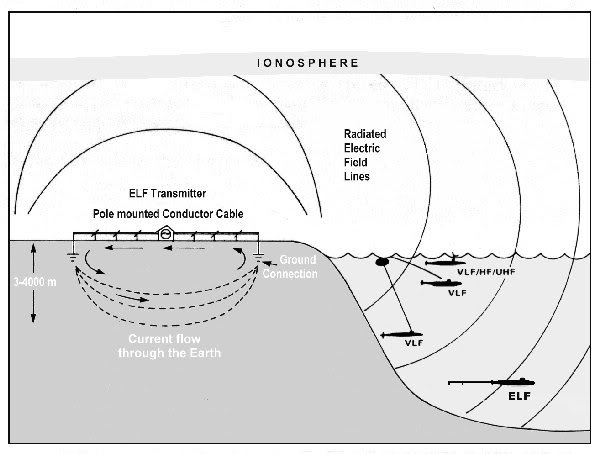Project Sanguine was a top secret military project that was instilled during the cold war era. This project was put forth to communicate with submarines all over the world using short coded messages that were ultra classified and secretive. These communication lines cover 84 miles of Michigan’s Upper Peninsula and northern Wisconsin.

Ocean communication issues and statistics
Communicating with vessels underneath the oceans surface was a major challenge during this time. before the ELF lines were put into place, in order to communicate with submarines deployed around the world, the submarine would have to move very slowly and be dangerously close to the surface. The reason that the ocean is so hard to send communication signals through is because it has a very high electrical conductivity. These breaks up signals very much especially as you get to any sort of depth in the water. To try and avoid detection from the Russians, the United States needed to be able to communicate with there Submarines at much greater depths and while the submarine is moving at patrol speeds. The ELF lines have a 76 Hz signal that forms very strong wavelengths able to penetrate very far below the oceans surface. The wavelengths generated are nearly 2500 miles which are very good for long distance communication.
Purpose and Importance
The importance of these ELF lines was made very clear by Admiral J. L. Halloway, he stated the following statement about the ELF lines and the safety of the United States. “I assure you that the need for ELF systems is real and urgent; that is works, and that there are no adequate alternatives for communicating with our submarines without the risk of detection. New Technology is rapidly increasing this danger. To keep our submarines safe, we have to keep them deep and there antennas away from the surface. To keep our country safe against the threat of nuclear attack, we must assure the safety of our submarine forces”. (3, p. 4). There are many quotes just like this one from military professionals stressing the need for these communication lines. These quotes speak volumes to the importance of the lines because these quotes are coming directly from people who’s safety relies heavily on communicating with the submarines deployed around the world.

Project Sanguine was proposed in 1968 by the U.S. Navy. This project was to install extremely low frequency (ELF) lines to communicate top secretly with submarines around the world. These lines could send short coded messages at a low data rate, for 24 hours a day, 7 days a week. These signals were used to summon specific submarine vessels to the surface. As shown in the image to the right, these Extremely Low Frequency lines could communicate with moving submarines hundreds of feet below the oceans surface. These short coded messages could be sent to any submarine around the globe and summon that specific submarine to the surface for further direction and communication. Project Sanguine consisted of two 14-mile lines in Wisconsin at the Clam Lake facility, and one 28-mile line in Republic, MI. The original Project order was to cover almost 40 percent of Wisconsin with underground wires, but this caused way to much raucous with the public eye as discussed later on. After the United States dropped two nuclear atomic bombs on Hiroshima and Nagasaki, nuclear deterrence and nuclear superiority were the highest priority for the United States and Russia entering the cold war era. Each country was racing against each other trying to gain a nuclear upper hand. With this arms race comes the rising importance of reconnaissance and secret intelligence. This is very importance because if Russia was to shoot nuclear missiles at the United States, the United States would be able to recognize that Russia launched them and retaliate accordingly before the missiles strike there target. These submarines were also armed with nuclear missiles that could be launched from the submarine to anywhere within its striking distance. This requires constant communication with these subs deep below the surface in order to make sure that if a nuclear strike is called by the president, the submarine that needs to launch this missile can do so right away. The capability to intercept communications and make retaliation possible for both sides is what keeps both governments at bay and not declare nuclear war on each other, which has the possibility to destroy both countries completely. The most secretive and and versatile reconnaissance and intelligence weapon at this time and arguably still today is the submarine. Communicating with these submarines around the world was vital to the United States nuclear deterrence plans. The importance of these communication lines was stressed over and over again by many people in the government, including world war 2 veterans. Secretary of Defense Dr. Harold Brown stated during Senate Appropriations Committee hearings, “ELF is an extremely important communication means, that without it our submarine force risks vulnerability because it has to be nearer to the surface than otherwise in order to receive signals”. (3, p. 4).
Project Sanguine’s non success and New Elf Project
Project Sanguine proposed that over 6,000 miles of underground cable covering about 6500 square miles in Michigan’s Upper Peninsula and Northern Wisconsin. This immense project was not backed up by the United States citizens very much at all. After years of fighting and protests, the United States Navy proposed a new plan called the Surface ELF Antenna For Addressing Remotely Deployed Receivers (SEAFARER). This proposal was much smaller than Project Sanguine, SEAFARER proposed that three above ground transmitters and 2400 miles of underground cable be installed. This would cover just 4700 square miles instead of 6000 like Project Sanguine suggested. This was still revised again to the final incarnation which was called Project ELF. Project ELF was finally put through and it built two transmitters with just 84 miles of cable hung above ground. Project ELF was installed and used for communicating with Navy submarines around the world until 2004 when they were deemed out of date and replaced with much better technology. If you visit Republic, Mi today you can go see where these ELF lines were built and how far they spanned if you follow the ELF line path which is still very visible today.
Why Michigan and Wisconsin
The reason choosing Michigan’s Upper Peninsula and Northern Wisconsin is in the dirt directly underneath the surface. The two things that are necessary to build working ELF lines are long antenna lines and a layer of low conductivity rock. Because of the bedrock specific to these two areas, the antennas could be shorter and use less power, while still producing the necessary signal to properly communicate with the Navy submarines. If these ELF lines were built anywhere else in the United States, the power necessary to get the equivalent signal is many times the power needed in these two areas because of the bedrock type would absorb most of the power. If the lines were installed elsewhere, the antennas would also be required to be much longer. This remote area of Michigan and Wisconsin is perfect because it is very remote which limits the chance of detection, and the cost of building is much cheaper because they don’t need as much land or material. This ended up not being super critical because the final construction project built the lines above ground, but these two areas were still used.

Public perspective and Environmental Impact
Project Sanguine was very controversial with the local citizens of northern Wisconsin and Michigan. The ELF lines were attacked several times legally and physically. Protesters used legal action against the lines and even cut the lines on five different occasions. The Project called for six thousand miles of cables to be buried in the bedrock underground, covering over 40 percent of Wisconsin. They were going to be powered by about 100 underground power plants. This much interference and Earth disturbance caused a major uproar with Environmentalist around the United States, as well as with the local citizens in these areas that would be directly affected by the installation of this exponential length of cable. After several protests and relentless grief from thousands of citizens, the United States Navy finally revoked the project and it was never completed. However, a Project ELF was kicked off in the 1980’s, and remained in use until 2004. This project was not nearly as big as Project Sanguine, covering just 84 miles of remote woodlands in Michigan near Republic and Gwinn, and also in Wisconsin near Clam Lake. Project ELF was much more acceptable to the local citizens and the rest of the United States, mainly because is only required a small fraction of cables be installed compared to the original Project Sanguine proposal. Project ELF also built the cables above the ground like a telephone wire (shown in the image above) instead of the original plan to put them six feet underground. This route was a lot cheaper and kept all the power travelling through these cables out of the ground. This was important in completing this project because that amount of power moving through the ground with underground cables made the public eye very nervous about the environmental impact. The first transmission successfully took place in May of 1982, this successful transmission gave the project a lot of support when people realized they work and the impact they could have. In order for this Project to succeed, the Navy had to prove to the people that these signals were not harmful to people. Even though the world’s electric power systems operate at the same frequency as these ELF lines, people were still unsure about the safety of these new lines. The Navy sponsored more than 60 biological research programs such as cell growth studies to the monitoring of test mammals in controlled ELF fields. All of these programs results came back negative further proving the safety of these communication lines. To further back their statement that these lines are safe, the United States Navy prepared an extremely comprehensive environmental impact statement (EIS). This assessed all of the effects that are possible from the ELF lines in great detail (too much for this story), but the conclusion of the EIS was that the ELF lines are compatible with a local environment as has been demonstrated by the WTF for years.
Primary Sources
- Feingold, Russell. (1995). “Extremely Low Frequency Communication System Termination and Deficit Reduction Act”. Congressional Record – January 4, 1995
- Booker H. G. and N. R. C. Summary Statement of the Ad Hoc Panel on Sanguine, Department of Defense, Defense Technical Information Center. 1972
- General Telephone and Electronics Corporations. (1982). “Information about ELF Communications”.
Secondary Sources
- Mike Sonnenberg (2019). “Project Sanguine in the Upper Peninsula” lostinmichigan.net
- Carlos A. Altgelt “The World’s Largest “Radio” Station”
- J. Wait. “Propagation of ELF electromagnetic waves and project sanguine/seafarer”. IEEE
- Robert Becker. “Cross Currents, The perils of Electropollution”
- Elizabeth Russell. “U.S. Navy Seafarer Program/Project ELF collection”.
Further Reading
- ELF Station Republic, MI (MHUGL: Bradley Villeneuve)
- Clam Lake, WI ELF Transmitter (MHUGL: Daniel Olson)
- Project Sanguine (MHUGL: Grant Cooper)

